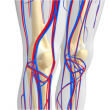In this large randomized trial, there were significant differences as regards both target-lesion failure and target-vessel-related infarction, which persisted through a 2-year follow-up and favored treatment with an ultrathin-strut bioresorbable-polymer sirolimus-eluting stent (Orsiro) compared with the gold standard, a durable-polymer everolimus-eluting stent (Xience). Moreover, there were significantly lower rates of target lesion revascularization and late/very...
Infrainguinal Bypass Following Failed Endovascular Intervention Has a Different Outcome
We often inform our patients we should first approach the superficial femoral with an endovascular intervention, and that should it fail or develop restenosis, we could always resort to a bypass. We were not lying when we’d assume a bypass following endovascular intervention would have the same outcome as a primary bypass. Simply put, no...
The Importance of Tibial Artery Patency in the Rechanneling of the Femoral Artery
After rechanneling occluded superficial femoro-popliteal arteries, interventional physicians are left with the question of how to proceed with infrapopliteal disease. This work (soon to be published in Eur J Vasc Endovasc Surg) shows us the importance of achieving patency in tibial arteries so as to obtain better mid-term outcomes. The gist is that, after an...
Predicting Coronary Angioplasty Benefits
Coronary angioplasty or percutaneous coronary intervention (PCI) reduces angina and improves quality of life in patients with stable ischemic cardiomyopathy, though the ORBITA study has shed new light on this. Meanwhile, we will assume this is indeed the case, until new studies either confirm or refute the above mentioned, controversial study. Either way, it is...
Coronary Disease in Diabetes: Diabetic Patients Have Much Greater Plaque Progression
Patients with diabetes mellitus experience significantly greater plaque progression, particularly regarding adverse plaque. Male sex and baseline plaque volume >75% were identified as independent risk factors for plaque progression; the latter actually tripled the risk. This study with tomographic follow-up sought to determine the rate and extent of plaque progression, changes in plaque features, and...
AHA 2018 | New-Generation DES Are Similar to Second-Generation DES Beyond Polymer
Sirolimus-eluting stents with biodegradable polymer did not offer better outcomes compared with instant-classic (and undoubtedly valid) everolimus-eluting stents with durable polymer such as Xience. New-generation drug-eluting stents (DES) offer better outcomes than first-generation devices after a 10-year follow-up, according to the ISAR-TEST 4 trial presented at the American Heart Association (AHA) Congress Scientific Sessions and published...
AHA 2018 | Use of Balloon Counterpulsation According to IABP-SHOCK II Trial
Following up on the 30 day and one year effect, the IABP-SHOCK II trial long term outcomes showed there is not benefit to the use of intraaortic balloon counterpulsation in cardiogenic shock patients undergoing acute myocardial infarction. The only work in this group of patients with long term follow up is the SHOCK trial published in...
AHA 2018 | Freedom Long-Term Follow-up: Still in Favor of CABG
Nearly 8 years later, CABG maintains its benefit over PCI-DES in terms of mortality in diabetic patients with multivessel disease, according to the Freedom trial, presented by Dr. Fuster at AHA and simultaneously published in JACC. CABG is superior to PCI-DES, with 36% higher mortality in these last years. Considering the nature of atherosclerosis,...
Clinical Utility of CT-Derived FFR for Decision-Making
In this large international multicenter population, computed-tomography (CT)-derived fractional flow reserve (FFR) modified treatment recommendation in two-thirds of subjects compared with CT angiography alone, and it was associated with less negative invasive angiographies. It also predicted revascularization and identified low-risk patients. A non-invasive means to know the anatomy and function of patients with stable chronic...
TAVR in Low-Risk Patients with “Zero” Mortality and “Zero” Stroke
Transcatheter aortic valve replacement (TAVR) is now the standard of care for patients with symptomatic severe aortic stenosis who are at extreme, high, or intermediate risk for surgery. This multicenter, prospective study (Feasibility of Transcatheter Aortic Valve Replacement in Low-Risk Patients With Symptomatic, Severe Aortic Stenosis) included low-risk patients and was approved by the United...









